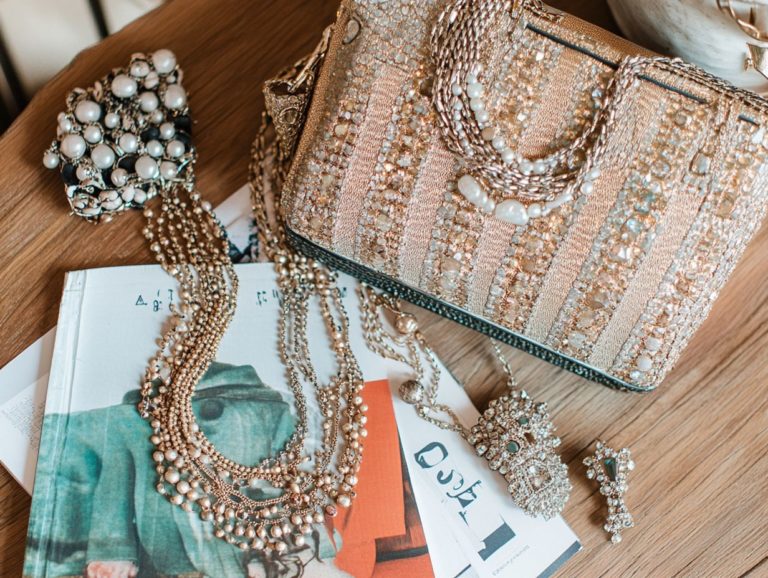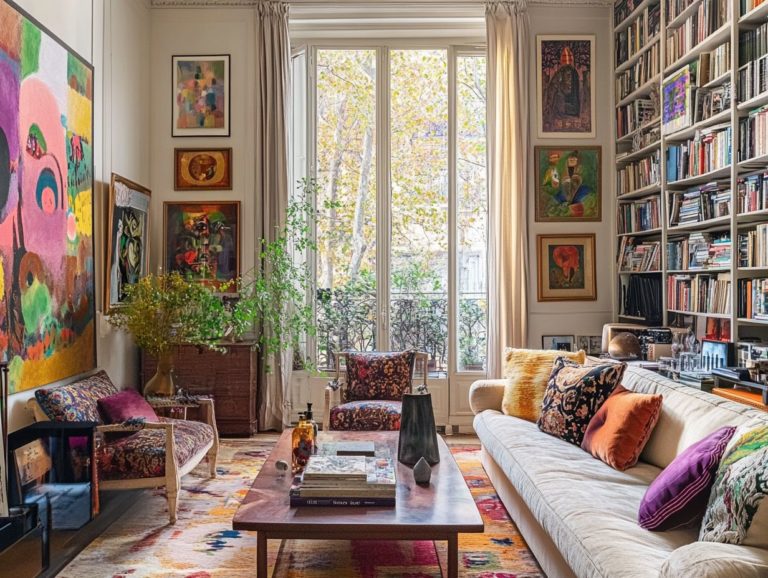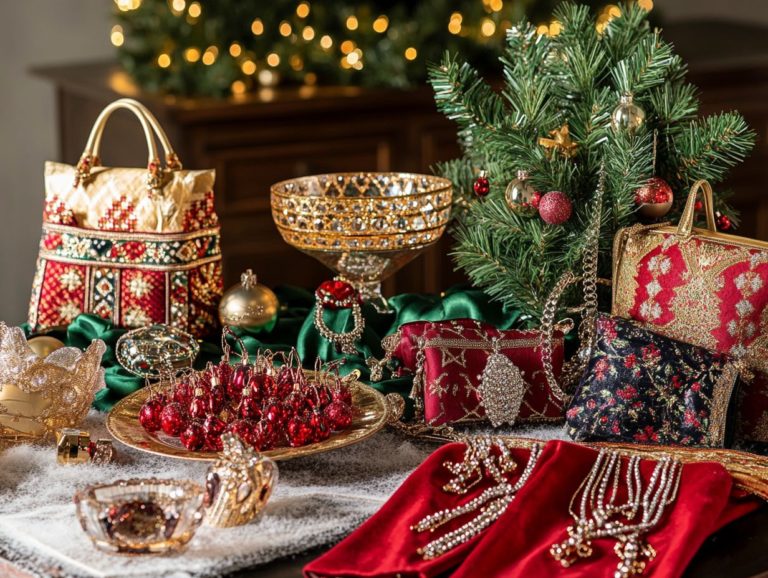How to Layer Textures with Accessories?
Layering textures with accessories can truly elevate your style, infusing depth and personality into any outfit. Discover the exciting world of textures and accessories right here!
This article explores various types of textures and accessories, offering insights on how to skillfully combine them. You ll uncover the benefits of layering, receive tips for selecting the perfect accessories, and follow a step-by-step guide to achieving breathtaking looks.
We will also highlight common pitfalls to avoid while showcasing a range of styles, from casual to formal.
Are you prepared to enhance your fashion game? Let s dive in!
Contents
- Key Takeaways:
- Understanding Textures and Accessories
- Why Layer Textures with Accessories?
- Types of Textures to Layer
- Choosing the Right Accessories
- How to Layer Textures with Accessories
- Mistakes to Avoid
- Creating Different Looks
- Frequently Asked Questions
- How to Layer Textures with Accessories?
- What are some popular textures to layer with accessories?
- How do I choose the right accessories to layer with different textures?
- Can I mix and match different textures when layering with accessories?
- How many textures should I layer with my accessories?
- What are some tips for layering textures with accessories in colder months?
- Can I layer textures with accessories for formal occasions?
Key Takeaways:
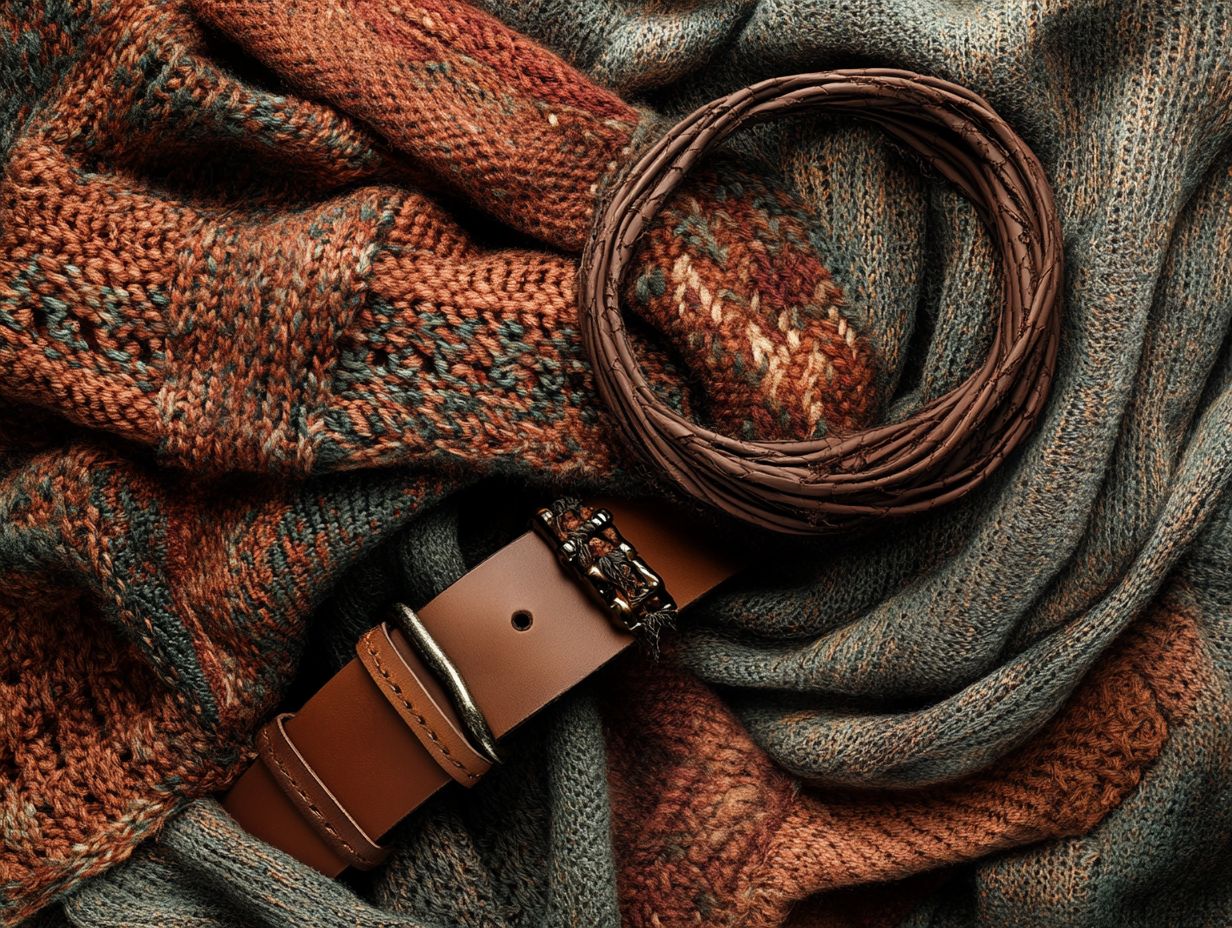
- Layering textures adds depth and interest.
- Mix and match for unique, versatile looks.
- Choose complementary colors and avoid overcrowding.
Understanding Textures and Accessories
Understanding textures and accessories is essential in the world of interior design, as they significantly shape the atmosphere and style of your unique space. Textures have the power to turn a simple room into a cozy haven, adding visual interest through a variety of textiles and materials.
By thoughtfully mixing textures like plush rugs, knitted throws, and natural wood elements in your home d cor, you can create an environment that genuinely reflects your personal style. Accessories enhance this transformation, making it crucial for you to grasp how they contribute to the overall design process.
What are Textures and Accessories?
Textures in interior design refer to the surface quality of materials. They can dramatically influence the atmosphere and style of your space. Accessories are those delightful items that elevate your home d cor.
Integrating a variety of textures not only adds depth and interest but also creates a smooth look throughout a room. Imagine a plush wool rug serving as a warm foundation, inviting comfort beneath your feet, while faux fur throws drape over sofas or chairs to evoke a sense of coziness.
Thoughtfully layering these elements can transform your space into an inviting atmosphere. For instance, pairing a sleek leather chair with a soft, woven blanket strikes a perfect balance between modern elegance and warmth.
Combining different materials, such as matte ceramics with glossy finishes, enhances visual intrigue, making your overall design more dynamically engaging.
Why Layer Textures with Accessories?
Layering textures with accessories can truly elevate your interior design, crafting a cozy atmosphere brimming with visual interest. This approach enhances the style and infuses depth, fostering engagement within your space.
By artfully combining different textiles like a chunky knit throw draped over a sleek leather couch or a rustic jute rug beneath your feet you can effortlessly introduce warmth and character to your home d cor.
Embracing this layering technique allows you to explore various styles, making it easier for you to achieve a coveted balance and symmetry in your design.
Benefits of Layering
The benefits of layering textures and accessories in your interior design are remarkable, offering enhanced comfort and increased visual interest. You can create a space that truly reflects your unique personality.
By thoughtfully combining a variety of materials think fabrics, woods, and metals you evoke an emotional comfort that transforms your house into a welcoming home. This approach not only showcases your personal style but also invites a sense of warmth and depth into your environment.
Feedback is essential in this design journey. Engaging with peers or clients can yield valuable insights into how textures interact, helping you make selections that harmonize beautifully. Ultimately, you ll discover which accessories elevate the overall style, ensuring that each layer adds a meaningful touch to the room’s narrative.
Now, it s time for you to try layering textures and accessories in your home!
Types of Textures to Layer
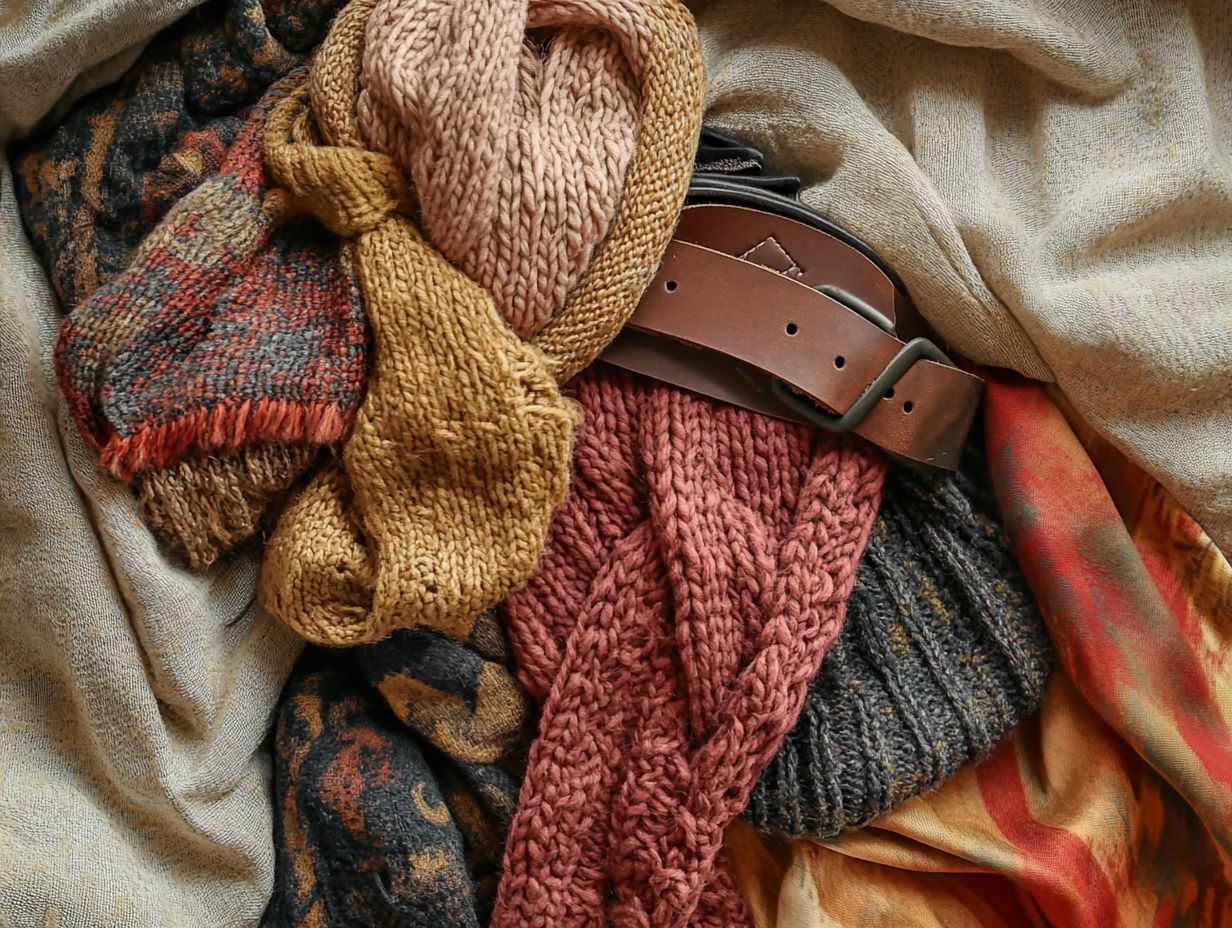
In the realm of interior design, you can layer a variety of textures to create a cohesive and inviting atmosphere. Fabrics, colors, and materials each possess unique qualities that enrich the design process.
Selecting textures like rattan, faux fur, or modern art can significantly influence the overall feel of the room. For example, pairing a soft wool rug with brass accents fosters warmth and adds sophistication.
Thoughtful choices are crucial to your design plan and play a pivotal role in ensuring client satisfaction.
Fabric, Color, and Material
The mix of fabric, color, and material is essential in creating visual texture and depth in your interior design.
Consider the diverse fabrics available: luxurious velvet, breathable cotton, and rugged leather. Each brings its charm and practical advantages. Velvet imparts elegance, while cotton fosters a casual, inviting atmosphere. Leather introduces a bold, sophisticated edge that beautifully anchors a room.
By thoughtfully combining these materials, you can achieve a balanced aesthetic. For instance, pairing soft cotton cushions with a sleek leather sofa enhances comfort while maintaining style. A warm color palette with earthy tones evokes coziness, whereas cooler shades provide a refreshing ambiance.
Ultimately, the right combination should reflect your personal taste, ensuring your space feels uniquely tailored and inviting.
Choosing the Right Accessories
Choosing the right accessories is essential for a polished look. It requires a discerning eye and a thoughtful strategy to harmonize and contrast elements that reflect your personal style.
Matching and Contrasting
Matching and contrasting textures and accessories can transform your space into a unique expression of style and comfort.
When done skillfully, this approach elevates a room’s aesthetic appeal and enhances its functionality and warmth. Imagine pairing a soft, cream-colored shag rug beneath your feet with a sleek chrome coffee table; this delightful juxtaposition invites engagement with the space.
These combinations encourage a layered look, providing varied tactile experiences that resonate with comfort and sophistication. Mixing materials thoughtfully creates an inviting atmosphere, ensuring every element reflects your personal tastes and lifestyle.
How to Layer Textures with Accessories
Layering textures with accessories can be an exciting adventure that transforms your home! This step-by-step guide will help you navigate the design process, emphasizing the importance of balance and symmetry.
Start by selecting a neutral color palette as your foundation, then gradually introduce an array of textures and textiles such as area rugs and cozy comfort items to enrich depth and visual intrigue.
Finally, complete the look with carefully curated accessories and plants, infusing warmth and personality into your space.
Get started on your texture layering journey today!
Step-by-Step Guide

Get ready to master the art of layering textures and accessories! This step-by-step guide empowers you to expertly layer textures for a harmonious and inviting interior design.
By thoughtfully curating each element, you can craft a space that reflects your unique style and resonates with your personal aesthetic. Begin with a foundational texture, like a soft wool throw or a sleek leather sofa. This sets the stage for your design journey.
Next, introduce layers using complementary materials. Think about adding plush cushions or woven blankets. They should enhance the initial texture without overwhelming it.
Accessorize with items that resonate with your preferences. Consider accent pieces like decorative vases, striking artwork, or trendy wall hangings that tie the space together.
These straightforward yet impactful steps can transform an ordinary room into your stylish sanctuary.
Mistakes to Avoid
Avoiding common mistakes helps you create a refined design that meets your clients’ expectations.
Common Layering Pitfalls
Avoid common layering pitfalls, which often stem from overcomplicating your design with too many contrasting elements. This can lead to a chaotic visual experience.
Such complexity can distract viewers and obscure your intended message. Prioritize clarity over extravagance. A practical tip is to limit your color palette to a few complementary shades that work harmoniously together.
Consider the hierarchy of your elements. Placing the most important information prominently creates a more intuitive flow.
Utilizing whitespace the space separating elements can help you separate distinct layers, leading to a more engaging and organized layout. By keeping things balanced and intentional, you guide the viewer’s eye while maintaining a cohesive aesthetic.
Creating Different Looks
Crafting diverse looks in interior design requires a thoughtful method. This allows you to transform your space, embodying a range of moods and styles that resonate with your personal aesthetic.
Casual, Formal, and Creative Styles
Casual, formal, and creative styles each have distinct characteristics showcased through intentional textures and accessories.
Casual style invites ease, favoring soft fabrics like cotton and linen paired with earthy tones for a warm atmosphere. In contrast, formal style embodies elegance, using luxurious textures such as velvet with polished metal or glass accents for added sophistication.
Meanwhile, creative style bursts forth with a mix of eclectic textiles and bold colors, complemented by innovative accessories like artisanal sculptures. This celebrates your unique expression.
The secret to blending comfort with aesthetic appeal lies in your thoughtful selection of these elements. Imagine a plush sofa adorned with artistic throw pillows this can seamlessly unite relaxation and visual intrigue across all three styles.
Frequently Asked Questions

How to Layer Textures with Accessories?
Layering textures with accessories is a great way to add depth and interest to your outfit. Here are some commonly asked questions about this styling technique.
What are some popular textures to layer with accessories?
Popular textures to layer with accessories include lace, denim, leather, and knits. These textures add dimension and can be easily paired with different accessories for a unique look.
How do I choose the right accessories to layer with different textures?
The key to layering textures with accessories is to balance them out. For instance, if you’re wearing a chunky knit sweater, pair it with delicate accessories like a dainty necklace or bracelet. If you’re in a smooth leather jacket, opt for bolder statement accessories.
Start layering today and transform your space into a reflection of you! Embrace your creativity and enjoy the process of designing a space that’s uniquely yours!
Can I mix and match different textures when layering with accessories?
Absolutely! Mixing textures creates a visually interesting and dynamic outfit.
Stick with a cohesive color palette to keep everything looking great.
How many textures should I layer with my accessories?
This depends on your personal style and the look you’re aiming for.
Try layering 2-3 textures to keep it balanced and appealing.
What are some tips for layering textures with accessories in colder months?
In colder weather, layer thicker fabrics like wool and fur.
Chunky accessories like scarves and hats add warmth and style!
Can I layer textures with accessories for formal occasions?
Definitely! Choose elegant fabrics like silk and velvet.
Pair them with delicate accessories such as pearls or diamonds to stand out!



